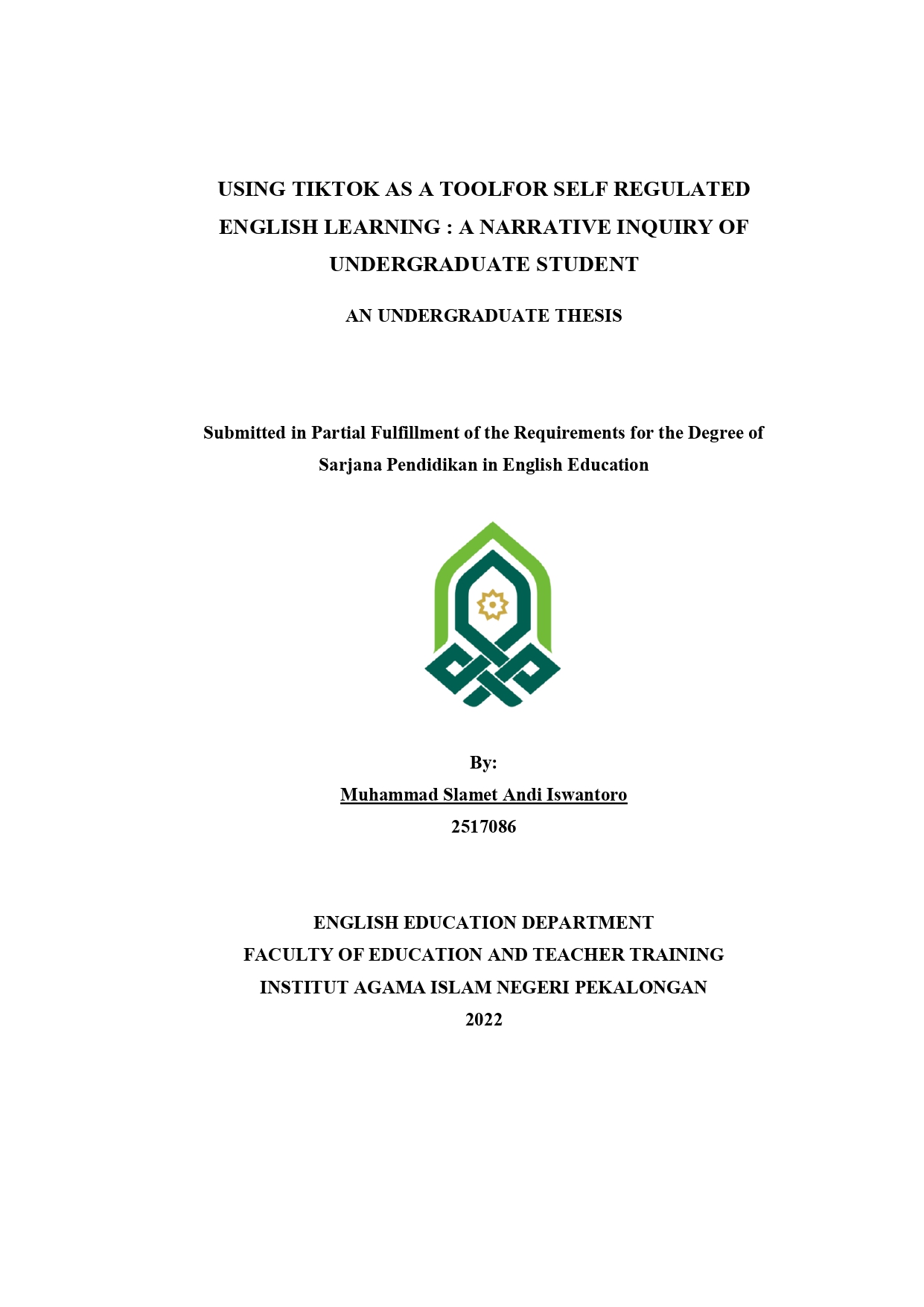
SKRIPSI TADRIS BAHASA INGGRIS
Using Tiktok as a Tool for Self Regulated English Learning : a Narrative Inquiry of Undergraduate Student
Tiktok is one of the applications that can be used to help students for self-regulated English learning. This study aims to find out how the students use TikTok English learning by focusing on Panadero theory, this study also investigates the obstacle the students encounter when using TikTok for English learning. This research is qualitative research with a narrative design. There are five participants in this study. The findings in this study are students applied the phase of self-regulated in using TikTok as a tool for English learning, including forethought phase, performance phase, and self-reflection. Besides that, the students also run into some obstacles when they use TikTok for English learning.
Keyword : Self-regulated English learning,Undergraduate students, TikTok
REFERENCE
Alguacil, M., Fajardo, E, P., Carril, L, S. (2021). Incorporating TikTok in higher education: Pedagogical perspectives from a corporal expression sport sciences course. Journal of Hospitality, Leisure, Sport & Tourism Education.
Alimemaj, Z. (2010). Youtube, Language Learning And Teaching Techniques (electronic version). The Global Journal of English Studies.
Anderson, K. E. (2020). Getting acquainted with social networks and apps: it is time to talk about TikTok. Library Hi Tech News.
Anggi, E. P., Naura, N. U., & Riska, S. S. (2021). Utilizing Tiktok Application as Media for Learning English Pronounciation. Suryakancana University.
Aprilian, D, Yessy, E, Vira,A. (2019). Jurnal Ilmiah Bimbingann dan Konseling. Hubungan Antara Penggunaan Aplikasi TikTok Dengan Perilaku Narsisme Pada Siswa Sekolah Menengah Pertama. 2 (3) : 221
Atsani, M. Z. (2020). “Transformasi Media Pembelajaran Pada Masa Covid-19”. Al-Hikmah. Jurnal Studi Islam. Volume 1 Nomor 1 : 82-93. Retrieved fromhttp://ejournal.kopertais4.or.id/sasambo/index.php/alhikmah/article/view/3905
Audrey A. (2021). Expanding ESL Students’ Vocabulary Through TikTok Videos.Kolej Vokasional Keninga.
Barkhuizen, G. (2014). Narrative research in language teaching and learning. Language Teaching, 47(4), 450-466. DOI: 10.1017/S0261444814000172
Brandt, B. A. (2013). The Learner’s Perspective. In S. Hase and C. Kenyon (Eds.) Selfdetermined learning: Heutagogy in action. London: Bloomsbury.
Chinnery, G. M. (2006). Emerging Technologies Going to the MALL: Mobile-Assisted Language Learning. Language Learning & Technology, 10(1), 9-16.
Clare Hayes, Katherine Stott, Katie J. Lamb*, and Glenn A. (2020). Hurst. “Making Every Second Count”: Utilizing TikTok and Systems Thinking to Facilitate Scientific Public Engagement and Contextualization of Chemistry at Home. J. Chem. Educ. 2020, 97, 10, 3858–3866.
Connelly, F. M., & Clandinin, D. J. (1990). Stories of experience and narrative inquiry. Educational Researcher, 19(5), 2-14. DOI: 10.3102/0013189X019005002
Creswell, J. W. (2014).Research Design: Qualitative, Quantitative, and Mixed Methods Approaches (4th ed.). USA: SAGE Publications, Inc.
El-Henawy, Walaa & Dadour, El Sayed & Mohamed M. Salem, Dr & Jehan M. ElBassuony, Dr. (2010). Self-Regulated Learning in English Language Instruction.
Hadijah, S. (2016) Teaching By Using Video: Ways To Make It More Meaningful In EFL Classrooms. Proceedings of the Fourth International Seminar On English Language and Teaching.
Harandi, S. R. (2015). Effects of e-learning on students' motivation. Procedia - Social and Behavioral Sciences, 181. https://doi.org/10.1016/j.sbspro.2015.04.905
Kukulska-Hulme, A. and Shield, L. (2008). An overview of Mobile-Assisted Language Learning: From Content Delivery to Supported Collaboration and Interaction. ReCALL, 20(3), 271 –289.
Lewis, T., & Vialleton, E. (2011). The notions of control and consciousness in learnerautonomy and self-regulated learning: A comparison and critique. Innovation inLanguage Learning and Teaching.
Liu, X., Zhang, L., Zhang, S., & Tian, Y. (2020). The Further Study of the Blended Learning Model of the Videoaural-oral Course-the Combination of Web-based Learning, Flipped Classroom and Face-to-Face Instruction. Education Journal, 9(3), 64– 72.
Loong, T. E. (2012). Self-regulated learning between low-, average-, and high math achievers among pre-university international students in Malaysia. European Journal of Social Sciences. 30(2). 302-312
López-Carril, S., Anagnostopoulos, C., & Parganas, P. (2020). Social media in sport management education: Introducing LinkedIn. Journal of Hospitality, Leisure, Sport & Tourism Education, 27, 100262
Manca, S., & Ranieri, M. (2016). Facebook and the others. Potentials and obstacles of Social Media for teaching in higher education. Computers & Education, 95, 216–230.
Manning, R. D., Keiper, M. C., & Jenny, S. E. (2017). Pedagogical innovations for the millennial sport management student: Socrative and Twitter. Sport Management Education Journal, 11(1), 45– 54.
Ketersediaan
| 23SK2325009.00 | SK TI 23.009 MUH u | My Library (Lantai 3. Local Content) | Tersedia |
Informasi Detail
- Judul Seri
-
-
- No. Panggil
-
SK TI 23.009 MUH u
- Penerbit
- Pekalongan : Jurusan S-1 Tadris Bahasa Inggris FTIK UIN K.H. Abdurrahman Wahid Pekalongan., 2022
- Deskripsi Fisik
-
xi, 45 hlm., 30 cm; Bibliografi: 46-50
- Bahasa
-
Inggris
- ISBN/ISSN
-
-
- Klasifikasi
-
371. 358
- Tipe Isi
-
-
- Tipe Media
-
-
- Tipe Pembawa
-
-
- Edisi
-
-
- Subjek
- Info Detail Spesifik
-
-
- Pernyataan Tanggungjawab
-
Muhammad Slamet Andi Iswantoro (25170886)
Versi lain/terkait
Tidak tersedia versi lain
Lampiran Berkas
Komentar
Anda harus login sebelum memberikan komentar
 Karya Umum
Karya Umum  Filsafat
Filsafat  Agama
Agama  Ilmu-ilmu Sosial
Ilmu-ilmu Sosial  Bahasa
Bahasa  Ilmu-ilmu Murni
Ilmu-ilmu Murni  Ilmu-ilmu Terapan
Ilmu-ilmu Terapan  Kesenian, Hiburan, dan Olahraga
Kesenian, Hiburan, dan Olahraga  Kesusastraan
Kesusastraan  Geografi dan Sejarah
Geografi dan Sejarah